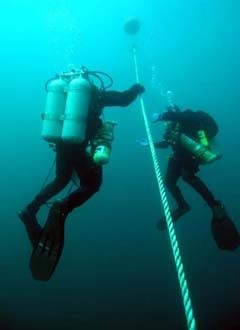NEWS RELEASE
CONGRESSMAN BART STUPAK 1ST CONGRESSIONAL DISTRICT OF MICHIGAN
************************* Stupak testifies on need to expand boundary of Thunder Bay Marine Sanctuary
WASHINGTON - U.S. Congressman Bart Stupak (D-Menominee) testified yesterday before the House Natural Resources Subcommittee on Fisheries, Wildlife and Oceans on the need to expand the boundary of Lake Huron’s Thunder Bay Marine Sanctuary.
In the congressional hearing, Stupak urged the subcommittee’s members to pass his legislation, H.R. 6204, the Thunder Bay National Marine Sanctuary and Underwater Preserve Boundary Modification Act.
“By authorizing an expansion to the Thunder Bay National Marine Sanctuary, the affected local communities would receive the benefits of having additional historical resources highlighted and preserved, as well as increased tourism, which is an important driver for economic growth,” Stupak told the committee.
Thunder Bay was declared Michigan’s first Great Lakes Bottomland Preserve in 1981 and in 2000 became the Great Lakes’ first National Marine Sanctuary.
The sanctuary is a federal-state partnership with a unique focus on preserving the large collection of underwater cultural resources, consisting of more than 100 shipwrecks spanning more than 200 years of Great Lakes shipping history.
A 1975 study by Michigan State University found that Thunder Bay potentially contained the largest number of historical shipwrecks in the country.
Stupak’s legislation would extend the sanctuary’s boundaries to include the waters off Alcona, Alpena and Presque Isle Counties and extend the sanctuary east to the international boundary with Canada.
The sanctuary currently covers 448 square miles of water and 115 miles of shoreline, protecting 116 shipwrecks.
Stupak’s bill would increase this area to 3,722 square miles of water and 226 miles of shoreline, with a total of 296 shipwrecks.
U.S. Senator Carl Levin (D-Mich.) has introduced companion legislation in the U.S. Senate (S. 2281).
Stupak noted that the sanctuary designation in no way impedes recreational boating or fishing in the area.
The Thunder Bay Sanctuary Advisory Council, a 15-member group representing local fishermen, business leaders, educators and government officials, has passed a resolution recommending the sanctuary be expanded.
“The Thunder Bay Marine Sanctuary is one of Michigan’s treasures that tells countless stories about our state’s history,” Stupak said. “I am pleased to work with my colleagues in the House and with Senator Levin to ensure that history is preserved.”
H.R. 6204 has been referred to the House Natural Resources Committee, which must act on the legislation before it is considered by the full House of Representatives.
Stupak is optimistic that the committee will soon approve the legislation.
The full text of Stupak’s testimony folows:
Thank you, Chairwoman Bordallo, Ranking Member Brown, and Members of the Subcommittee for holding this hearing on H.R. 6204, the Thunder Bay National Marine Sanctuary and Underwater Preserve Boundary Modification Act.
I also want to thank the bill’s original co-sponsors Congressman Kildee and Congressman McCotter, whose efforts have been instrumental in bringing my bill to the Committee.
In 1975, Michigan State University in response to local interest collected an inventory of shipwrecks located within Lake Huron’s Thunder Bay.
What they found was that Thunder Bay potentially contained the largest number of historical shipwrecks in the country.
This discovery warranted the establishment of an underwater "reserve" and in 1981 the state of Michigan declared Thunder Bay as Michigan's first Great Lakes Bottomland Preserve.
Following this state recognition, the National Oceanic and Atmospheric Administration designated the Thunder Bay National Marine Sanctuary in 2000 making it the first sanctuary in the Great Lakes.
The Sanctuary is a federal-state partnership with a unique focus on preserving the large collection of underwater cultural resources.
These resources consist of over 100 shipwrecks spanning over 200 years of Great Lakes shipping history.
In order to study and preserve the cultural resources present at Thunder Bay, the National Oceanic and Atmospheric Administration and the State of Michigan established the Great Lakes Maritime Heritage Center in Alpena, Michigan in 2005.
The Great Lakes Maritime Heritage Center allows visitors to learn about Great Lakes’ maritime history, explore shipwrecks via live video feeds, and see how archaeologists continue to work to preserve these historic sites.
To continue this positive outcome, the Thunder Bay Sanctuary Advisory Council, a fifteen-member group representing local interests such as fishermen, the business community, educational institutions and local government have passed a resolution that recommended the sanctuary be expanded.
My legislation, H.R. 6204, would extend the sanctuary’s boundaries to include the waters off Alcona, Alpena and Presque Isle counties in Michigan and extend the sanctuary east to the international boundary with Canada.
Currently, the sanctuary covers 448 square miles of water and 115 miles of shoreline, protecting 116 shipwrecks.
H.R. 6204 would increase this area to 3,722 square miles of water and 226 miles of shoreline, adding an additional 180 shipwrecks to the Sanctuary.
In addition, the legislation would direct NOAA to produce updated charts of the newly designated areas and apply the protection and preservation provisions in the existing management plan to the newly added areas.
By authorizing an expansion to the Thunder Bay National Marine Sanctuary, the affected local communities would receive the benefits of having additional historical resources highlighted and preserved, as well as increased tourism, which is an important driver for economic growth.
The Senate companion bill, S. 2281, introduced by Senator Carl Levin, was approved by the Committee on Commerce, Science, and Transportation on May 15, 2008.
It is my hope that this committee will also support this legislation, so we may make this expansion a reality.
I thank you again for allowing me to testify, and for your consideration of my legislation.
*************************
